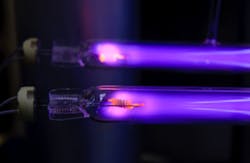Coming soon in the August issue of Water Technology, our Editorial Director Rich DiPaolo writes about the evolving UV marketplace. In the article, UV insiders such as Jack Holmgreen weigh in on the past, present and future of this technology.
This disinfection technology for water can be traced back to the early 1900s in the U.S. And, by 1966, the Department of Health, Education and Welfare (DHEW) issued guidelines for its use. DHEW’s recommended minimum standard of UV dosage, which is measured in millijoules per square centimeter (mJ/cm2), was 16 mJ/cm2.
Years later, NSF also set a standard for its Class B units at 16 mJ/cm2; the NSF standard for Class A systems is 40 mJ/cm2. The EU standard is 30 mJ/cm2 and the state standards vary, explains Holmgreen, president of SparkleTap Water Company.
Emerging trends
DiPaolo also spoke with others about the emerging trends in the UV market. In an interview, not printed in the issue, DiPaolo spoke with Robert Dash of VIQUA about his predictions for this technology.
"In the near term these [traditional] lamps will continue being used until displacement by other technologies becomes cost effective and commercially available for large flow applications," explains Dash. "For mercury lamps, the main improvements will likely to be focused on high efficiency 254 nm low pressure lamps with increased power output per unit lamp length. This allows for decreased lamp count and increased energy savings when high total UV power and/or confined spaces are required."
Applied uses
According to those we spoke with for this article, UV disinfection technologies continue to gain acceptance and interest from several target markets and for a few different uses. For example, notes Gregory Boehme, application manager for Atlantic Ultraviolet Corporation, in addition to disinfecting water, UV is also being used for air quality and surface cleaning services.
"We’re also seeing growing interest from green buildings for water reuse," adds Boehme. "People are taking gray water, treating it and using it for such things as flushing toilets and irrigation."
These trends can help dealers utilize their UV knowledge in many different areas today. To learn more about the evolving trends in the UV market, be sure to check out Water Technology’s August issue. See below for related information:
